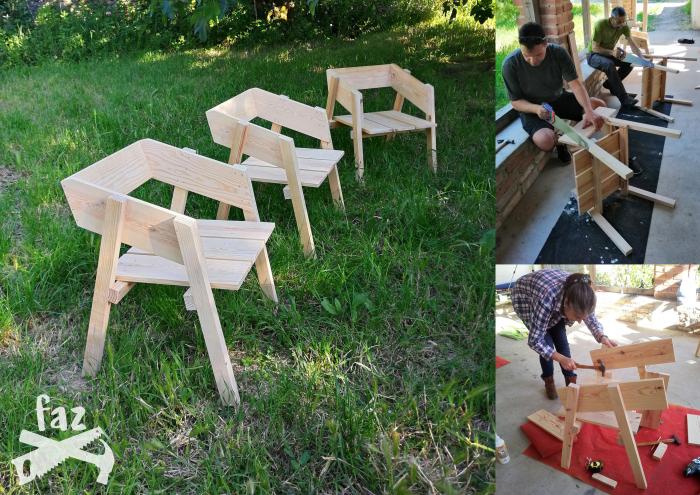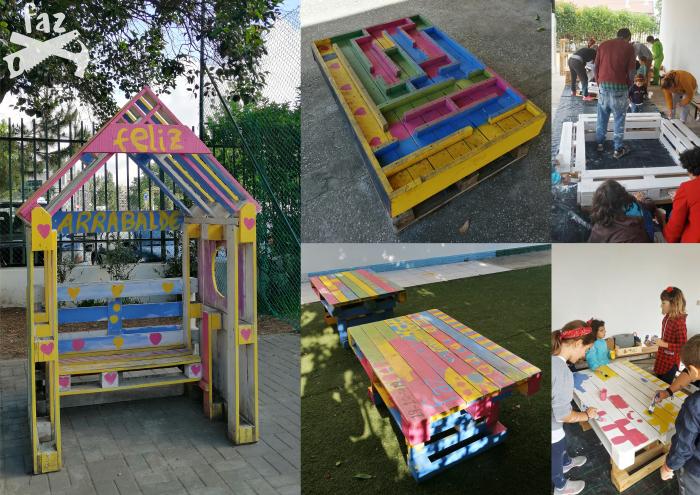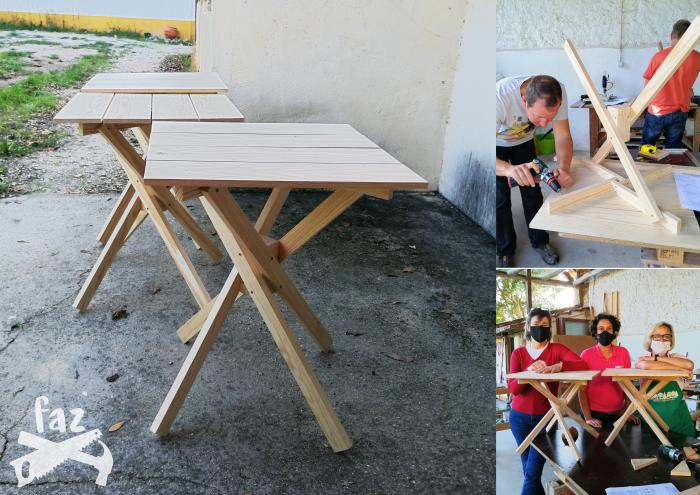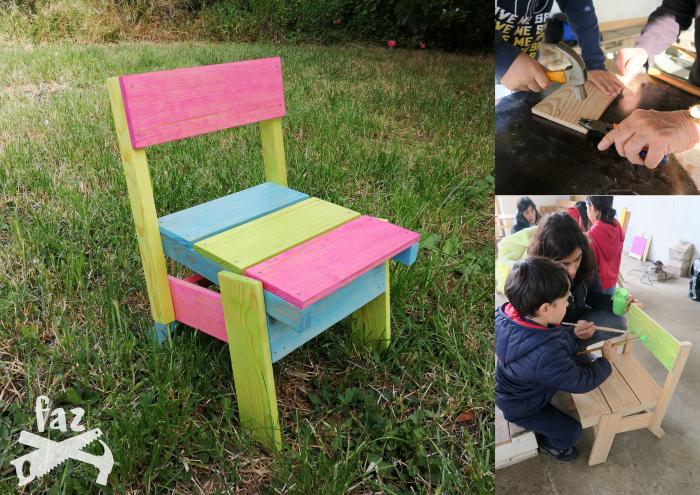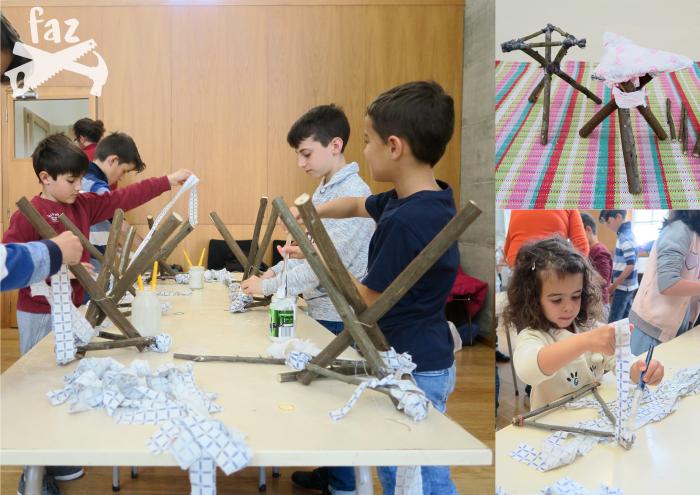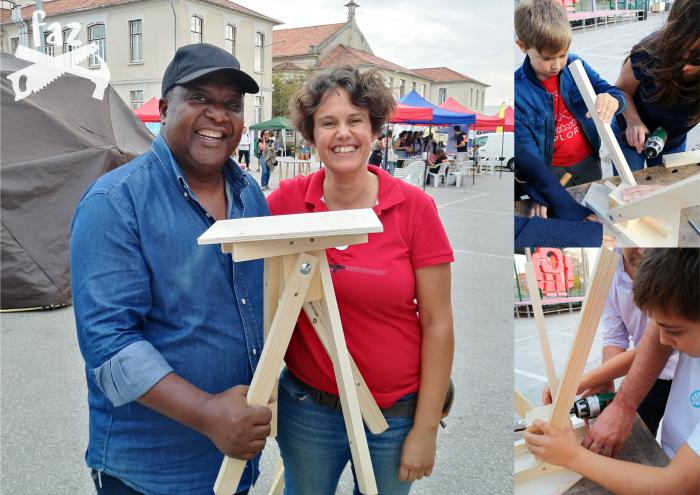I. SUMMARY INFORMATION
Project
269409
Status
Submitted
Award category
Techniques, materials and processes for construction and design
You want to submit
NEW EUROPEAN BAUHAUS AWARDS : existing completed examples
Project title
FAZ com as tuas mãos
Full project title
FAZ com as tuas mãos (DO IT with your hands)
Description
The revolution in manufacture is happening, design is at service of user-makers:
DO IT with your hands (FAZ com as tuas mãos)!
Change your mindset: everyday use products don't have to be made by industry. FAZ are easy to build designs and classes to demystify wood furniture making and empower people to do their own furniture. Each piece is designed to be easy to build, with basic tools and easy-to-find materials. Your handwork provides more gratification than mass-produced goods consumerism.
Where was your project implemented in the EU?
Portugal
Leiria
Av. Combatentes da Grande Guerra, nº61 5ºesq., 61
39.74900768441284
-8.794719936011031
Leiria
2400-123
When was your project implemented?
Has your project benefited from EU programmes or funds?
No
Which programme(s) or fund(s)? Provide the name of the programme(s)/fund(s), the strand/action line as relevant and the year.
II. DESCRIPTION OF THE PROJECT
Please provide a summary of your project
FAZ com as tuas mãos (DO IT with your hands) is a participatory process to produce furniture pieces. I have designed easy to make furnishes, with available materials and basic tools and teach people how to do them.
Maybe furniture doesn't have to be made by industry, woodworking doesn’t have to be joinery, nor about wood composites with “perfect” finishes. Maybe if we just go a step back and take a modest and simpler approach, we can make something new: democratize access to furniture made by users.
FAZ challenge is to produce locally, with whatever is available nearby, prefer renewable, biodegradable, low carbon footprint and/or from circular materials, use basic and generalized use tools, empower people to do it themselves and share designs. In this sense, I designed a chair, a stool, a bench, a table, children's chair and table, and playground objects that balance functionality and aesthetics with self-building values. Each piece is made of: 2 or 3 different references of local pine wood; used palettes and any raw or reclaimed planks; standard worldwide retailer cutted wood; or just free growing twigs of invasive species.
Workshop classes happen regularly, some are for adults, other for children, same for both and others for communities.
Each piece of furniture is built by a sum of fractions using simple overlap and triangulation to steady the furniture, and fixed with nails, screws and PVA glue. Use a screwdriver and hammer to assemble parts, in some cases, short cuts with a handsaw, others are simply brushed with PVA reinforced with old cotton fabric. Participants make a piece in between 30 minutes to 6 hours, and take a ready to use piece of furniture home or contribute to equip a community place.
The gratification of doing something with our own hands increases self-esteem. The fast and easy approach to woodworking experienced in the workshop reveals DIY as a real and desirable alternative to shopping.
Please give information about the key objectives of your project in terms of sustainability and how these have been met
The production-distribution-consumption chain is broken. Exchange to: local materials, all-over available tools and production on demand.
In order to feed mass consumption wholesaler chains force manufacturers to lower costs: production is displaced to countries where the workforce lives in humanly degrading conditions; the quality of the materials is reduced; the raw materials and final product travel globally and the entire chain is dependent on fossil fuels. I don’t want to make part of it:
Decentralized production and basic tools
Instead of big factories mass producing and worldwide distributing, make it small and multiply the production points worldwide. To create a business model able to achieve this goal I have designed furniture pieces to be built just with easy techniques and low tecnologie tools.
I designed furniture to be made with just a few common hand tools. Each model is the result of a conscious choice of operations made with simple tools and without expertise. By choosing commonly available tools I’m opting to avoid consumption of new tools.
Renewable local raw materials
Choose easy to find materials in the exact amount, prefer from local sources or just upcycle what is available. I chose wood because it is a nearly universal material, very easy to work with and with a fantastic height-toughness relation. If you choose just the one from local responsibly managed forests, it is a negative emission material. Beyond that, it is very appropriate to source it from upcycle.
Fittings are: nails, screws, PVA glue and/or pieces of used cotton fabric.
These are chosen by the racio: fixture capacity - application easiness and amount of emissions. In that sense, wood metal connectors were discarded, as they have a large amount of high emmisse production material (steel) for the effect of stabilizing the piece of furniture, when you can achieve it simply by the right furniture design.
Please give information about the key objectives of your project in terms of aesthetics and quality of experience beyond functionality and how these have been met
How to offer a real alternative to buying furniture?
We live in a society with a wide range of object choices to reach the same functionality. An alternative will have to be as appealing as those. For that goal I have designed the pieces in a clean and contemporary aesthetic, very honest in the way it is built, with enough character to be constituted as a brand. This, with the aim of creating objects of desire, boosting people's attention and participation.
FAZ is more than an object, it is an experience.
FAZ com as tuas mãos is not just a set of easy to do furniture models, are workshops for beginners. A participatory learning model creates an immersive experience of how easy, fast and gratifying this handwork is. In the workshops, participants experience how feasible these furniture pieces are to make. In the design phase, each decision in the form of the piece of furniture is made taking into account the difficulty and time of each operation, as well as the level of expertise of the participants. These are designed to be enjoyed to build. Each piece takes between 30 minutes, in the case of the stool, to 6 hours, like the armchair, to be made. Techniques in use are fast and easy learning curve, therefore you feel instant gratification by the immediate results of having a ready to use piece of furniture. Furthermore, the gratification of doing something with our own hands increases self-esteem.
Please give information about the key objectives of your project in terms of inclusion and how these have been met
FAZ production methods were chosen for their accessibility in means of equipment and skills. To become a widespread practice, making our own furniture has to be almost as accessible as knitting yourself a piece of clothing. No special installations are needed, everyone is invited and there are classes for all ages. For that aim, I prefered the manual tools, the ones you can borrow from your neighbor: handsaw, hammer, set square, tape-measure, pencil or just paint brush and scissor. The electric screwdriver is the exception.
Wood has an excellent cost - efficiency ratio, compared with metal or plastics to make furniture. Apart from that the tools are cheaper to purchase. The wood used in FAZ workshops is pine from local sources, but it can be any other softwood. And with the goal to make it as universal as possible, I'm investigating the use of free materials, like the Acacia melanoxylon twigs (a invasive species) I use in the stool children's workshop. In the workshops where the furniture isn’t meant to be transported, upcycling pallets is a very cheap option.
There are different formats of workshops: one piece of furniture per individual adult participant; one piece per pair adult-child; one piece per child; several pieces by a mixed group.
The chosen tools to each format depend on the size and age range of the group, taking in consideration safety, adequacy of tasks to motor skills and attention needed to teach the techniques. In that sense each workshop covers a specific situation, and I depend on my designer skills to create each piece of furniture combining the period of time available to be constructed, amount of tools, technical skills, and sometimes the source of materials.
For the twigs stool workshop I have a large group of unaccompanied children in ages that don’t master knots and a super low budget. Therefore I opt for school available tools: brush and scissors, free materials: twigs and upcycled cotton fabric creating bonds with non toxic PVA glue.
Please give information on the results/impacts achieved by your project in relation to the category you apply for
FAZ com as tuas mãos is led by a single person: I’m the product designer-maker-teacher-marketer. I’m graduated in Product Design, taught at the university and worked in different industries. I have always manufactured my designs from handcrafted to digital technologies. FAZ was launch in October 2018, since then, I have developed 9 different workshop models, with 12 different product models, in 16 events, 73 pieces have been made by more than 80 participants.
FAZ is a set of principles to divert people's attention from consumerism offering a viable alternative to satisfy the need for a new piece of furniture. Along the way, people discover a rewarding activity. They take a more sustainable path, becoming more aware and active citizens in a greener economy. And in this sense I can say the impacts are:
Shifting from buy to do it
The quality of the objects built in the workshops means that, at the time of the purchase decision, the option of a DIY object is considered by most of the participants. People choose to offer a workshop sign up than to buy gifts. Some ask to redesign models to their needs or available materials. Others make classes at their places as a way to furnish and as a social event.
Handwork to self-esteem
The gratification achieved by the participants is almost additive, they repeat the experience. A big part of them have started making woodworking after the classes. Some repeat workshops to make different models, or even, the same one, again.
Prefer local
Orders for woodwork have increased, people value buying something locally produced by an artisan rather than buying a cheap item on the internet.
Value materials
“A discarded board is a find”, the participants of the workshops look at the waste materials as an opportunity: "what can I do with this?". Workshops participants value much more the pieces they have made from the ones they buy, they don’t discard them easily because they create an effective relacion due to the experience.
Please explain the way citizens benefiting from or affected by the project and civil society have been involved in the project and what has been the impact of this involvement on the project
With FAZ workshops citizens and organizations have been able to equip themselves at a lower cost than to buy equivalent products in the market. In addition they benefit from the social event itself: a group of people with the same interest get together to be productive. The individual participant workshops are organized to be in a very relaxed ambience: a small group joins at the weekend, no noisy or dangerous tools are used, lunch is a chill out social time, and, at the end of the day, you take home the reward of your work.
This experience changes the way participants value simple materials, transforming them into stylish pieces, with few technical resources and in a short time, is revealed as an alternative to mainstream consumption. People feel encouraged to create their own designs inspired by the simple way FAZ models are built. Also, teached by the example, people choose low footprint materials. The shift is made: workshop participants are now agents in making many other things.
Other models of workshops are meant to benefit institutions. Designed to be built in community, were participants contribute volunteering. The FAZ pallet bench is an example, designed to furnish a community garden with the aid of their users, people trade their work for the benefit of all and in return learn how to make it and take document instruction to replicate it.
Other examples are a playhouse, a children table, a balance labyrinth and a sandbox that were designed to be made by a group of parents for their children's school. A wholesaler was pleased to offer tools and materials as part of his social responsibility, a transportation company offered a bunch of pallets, city council and a local association made the marketing. It took one day of work, teachers, functionaries, parents, family, friends and children, all together, contributed to the benefit of the school playground. The sense of joy, pride and self empowerment are main factors to make this community more resilient.
Please highlight the innovative character of the project
In this project the innovation is the process to use design practice tools to conceive objects, not to industry, but to a different approach to produce everyday things. We have come detached from the way things are made because of the super offer of affordable goods. In some cases, either because of the nature of the technique involved, or because of the easy access of the materials, industry didn’t leave in oblivion the artisanal way to do things, such as sewing clothes example. Unlike it, woodworking hasn't been very present as an option to be self-made.
Now society tends to take a step back because of the ecologic emergence awareness or just because we are saturated with meaningless goods. There is a trend to search for objects with craft value and a behind story. In this sense, DIY culture became very popular because of its affordability and people's desire of self-fulfillment in decelerating hobbie activities, fortifying their freedom and autonomy.
Despite the huge offer made available on the internet, DIY projects tend to be aesthetically unappealing. I struggle myself to find one there I’ll like to have. In FAZ com as tuas mãos designs I look for a compromise between aesthetics, functionality and the particular way these objects are made, I try not to offer just another crafty DIY idea from Youtube, but an elegant piece suitable to be on sale in a design boutique.
Considering the woodworking techniques, the innovation is quite subtil, maybe it is just a compromise that we haven’t been able to do: we can compromise the durability of a piece of furniture in solid wood to embrace the ease of construction. We can do this, as long as we are not creating problematic waste, as is the case of short-lived furniture made of melamine-coated wood particle boards.
Woodworking courses tend to be intensive and in traditional practices, at another side there are the enthusiasts for digital tools, FAZ offers a more affordable, instant and ready to use day-by-day solution.
Please explain how the project led to results or learnings which could be transferred to other interested parties
Who could have anticipated that there are so many inexpert people willing to try a seemingly difficult technique? Who would have thought that parents lead children to use tools?
What other techniques are waiting to be adapted to a more participative production process? Imagine a catalog of creatives with different aesthetic currents where we can choose the piece that most appeals to us. Why not a product brand that doesn't sell goods, but teaches you how to make them? What if instead of a production point that distributes to many points of sale, we had places in our community where we can go to make the piece we need, like the FabLabs? We could just distribute the knowledge of how to do it. It could be a network of individual appropriations and local adaptations in order to exponentially evolve into: greener materials; wider source of circular materials; alternatives for unavailable tools; other techniques; bigger range of objects; different aesthetics; and useful documentation to replicate workshops. Available platforms such as Wikifactory, Maker Movement and Distributed Design Market Platform can be used.
Different types of local businesses can be born from this buzz: suppliers of raw materials, training places, exhibition of articles and even selling points may be available on a map with addresses.
How is the ID sustained?
FAZ designs are original, authorial and free to use (CC BY-NC-ND 4.0). Workshop participants are encouraged to share the building instructions with friends. When the pieces are built for commercial purposes a royalty is requested. As in cultural activities, financial returns may not be immediate or obvious, some chances are: donations from Patreon or Crowdfunding, workshops fees, design consulting and product sales.
Who could guess that a single person, without budget, or support, in 31 months, with a pandemic in between, could put more than 80 people to produce furniture? What can this become with the right support?
Is an evaluation report or any relevant independent evaluation source available?
No
III. UPLOAD PICTURES
IV. VALIDATION
By ticking this box, you declare that all the information provided in this form is factually correct, that the proposed project has not been proposed for the Awards more than once under the same category and that it has not been subject to any type of investigation, which could lead to a financial correction because of irregularities or fraud.
Yes
